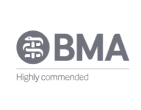Abortive treatment options for your headache patient
The goal of treatment for an individual headache occurrence is to reduce the severity and duration of the attack. Another goal is to reduce disability, allowing the patient to return to normal activities and responsibilities as quickly as possible.
The physician’s goal is to reduce medication use and avoid overuse of medicines. Also, we want to treat the headache as specifically as possible, avoiding trial and error.
We typically divide episodic treatments into abortive medication and rescue medication. Here we’ll discuss abortive medication, and later we’ll discuss rescue medication.
Become a great clinician with our video courses and workshops
Abortive treatments for headaches
Abortive treatments acutely and specifically attack migraine pain and migraine mechanisms by causing vasoconstriction. Common medicines used are the ergotamines and triptans.
Ergotamine
Ergotamine tartrate is a migraine medication which stimulates a wide variety of serotonin receptors. Ergotamine is poorly absorbed when taken orally and is available as suppositories.
Dihydroergotamine can be administered intravenously, intramuscularly, or subcutaneously, and intranasally. When used parenterally, it is given following an antiemetic. The intravenous dose can be repeated every 8 hours for 3–5 days if needed, to sustain relief in refractory patients.
Ergotamines are contraindicated in pregnancy, uncontrolled hypertension, coronary artery disease, peripheral vascular disease, sepsis, and liver or kidney disease. They also should not be used with macrolide antibiotics.
Triptans
Triptans also stimulate serotonin receptors, but do so more selectively. They come in various forms including injections, intranasal preparations, tablets, and oral disintegrating tablets. Several options are available by tablet and they have varying half-lives and pharmacokinetics.
Having a variety of administration choices helps the physician to tailor the choice of therapy to a patient’s needs and circumstances. The subcutaneous methods of administration work the fastest, with the intranasal sprays acting the next most rapidly.
A treatment is effective for a patient if the headache is relieved within two hours, but the rate of rebound headache must also be examined.
If a patient has a slow onset of headache that is long lasting, as seen in menstrual-associated migraine, a longer acting formulation with slower onset may be warranted.
One key to effective use is urging patients to take the dose as early as possible after the headache is noted. Delays may result in the medication being ineffective. Once a headache reaches a stage of central sensitization, associated with the development of allodynia, triptans generally lose efficacy. Other symptoms such as nausea are often aided by triptans.
Contraindications to triptans include a history of stroke, heart attack, coronary artery disease, hemiplegic migraine, uncontrolled hypertension, migraine with brainstem aura, and peripheral vascular disease.
That’s it for now. If you want to improve your understanding of key concepts in medicine, and improve your clinical skills, make sure to register for a free trial account, which will give you access to free videos and downloads. We’ll help you make the right decisions for yourself and your patients.
Recommended reading
- Blumenfeld, AM. 2018. Botox for chronic migraine: Tips and tricks. Practical Neurology. 17: 27–36. https://practicalneurology.com
- Halker Singh, RB, Starling, AJ and VanderPluym, J. 2019. Migraine acute therapies. Practical Neurology. 17: 63–67. ttps://practicalneurology.com
- Krel, R and Mathew, PG. 2019. Procedural treatments for headache disorders. Practical Neurology. 17: 76–79. https://practicalneurology.com
- Mauskop, A. 2012. Nonmedication, alternative, and complementary treatments for migraine. Continuum (Minneap Minn). 18: 796–806. PMID: 22868542
- Motwani, M and Kuruvilla, D. 2019. Behavioral and integrative therapies for headache. Practical Neurology. 17: 85–89. https://practicalneurology.com
- Natekar, A., Malya, S., Yuan, H. & Nahas, S. 2018. Migraine Preventative Therapies in Development Practical Neurology. 17: 54–57.
- Parikh, SK and Silberstein, SD. 2018. Calcitonin gene-related peptide monoclonal antibodies. Practical Neurology. Feb: 20–22. https://practicalneurology.com
- Rizzoli, PB. 2012. Acute and preventative treatment of migraine. Continuum (Minneap Minn). 18: 764–782. PMID: 22868540
- Tepper, SJ and Tepper, DE. 2018. Neuromodulation and headache. Practical Neurology. 17: 42–45. https://practicalneurology.com
Become an expert



